In this composite image of the merging cores of the Antennae Galaxies, optical (white and pink), radio (blue) and millimeter/submillimeter (orange and gold) images are combined to show the history and future of star formation. The optical image represents stars that are shining now. The radio image highlights gas that is probably too thin to become a star, and at the mm/submm wavelengths we can see the areas where new stars will likely form.

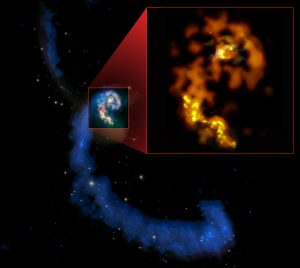
Antennae Galaxies
Hard to believe that this was once a pair of spiral galaxies. Undergoing a violent merger, the well-named Antennae Galaxies are quite a spectacle to radio telescopes. In blue are the data from the VLA, showing the trails of hydrogen stripped from the outer arms of the two spirals. In orange and gold (inset) are the data from ALMA showing the areas of star formation caused by the collision of gas and dust clouds.
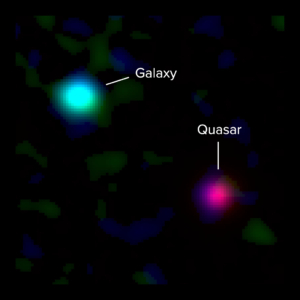
Composite ALMA and Optical Image of High Redshift Galaxies
Composite ALMA and optical image of a young Milky Way-like galaxy 12 billion light-years away and a background quasar 12.5 billion light-years away. Light from the quasar passed through the galaxy’s gas on its way to Earth, revealing the presence of the galaxy to astronomers. New ALMA observations of the galaxy’s ionized carbon (green) and dust continuum (blue) emission show that the dusty, star-forming disk of the galaxy is vastly offset from the gas detected by quasar absorption at optical wavelengths (red). This indicates that a massive halo of gas surrounds the galaxy. The optical data are from the Keck I Telescope at the W.M. Keck Observatory.
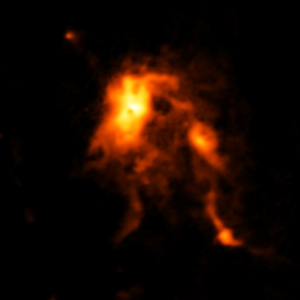
ALMA Image of the Glowing Dust Inside NGC 6334I
ALMA image of the glowing dust inside NGC 6334I, a protocluster containing an infant star that is undergoing an intense growth spurt, likely triggered by an avalanche of gas falling onto its surface.
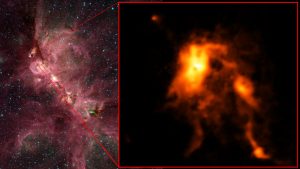
Protostar Blazes Bright, Reshaping Its Stellar Nursery
Inside the Cats’s Paw Nebula, as seen in an infrared image from NASA’s Spitzer Space Telescope (left), ALMA discovered that an infant star is undergoing an intense growth spurt, shining nearly 100 brighter than before and reshaping its stellar nursery (right).
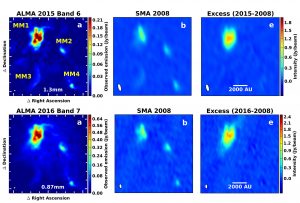
ALMA and SMA Images of NGC 6334I
Comparing observations by two different millimeter-wavelength telescopes, ALMA and the SMA, astronomers noted a massive outburst in a star-forming cloud. Because the ALMA images are more sensitive and show finer detail, it was possible to use them to simulate what the SMA could have seen in 2015 and 2016. By subtracting the earlier SMA images from the simulated images, astronomers could see that a significant change had taken place in MM1 while the other three millimeter sources (MM2, MM3, and MM4) are unchanged.





